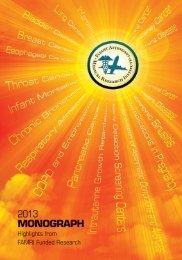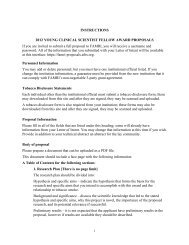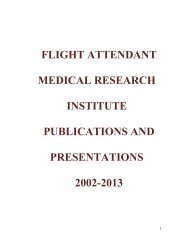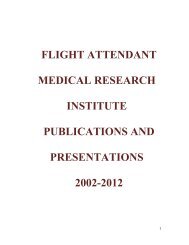MISSION
2009 compendium of FAMRI-supported research - Flight Attendant ...
2009 compendium of FAMRI-supported research - Flight Attendant ...
You also want an ePaper? Increase the reach of your titles
YUMPU automatically turns print PDFs into web optimized ePapers that Google loves.
factor-1 (COUP-TF1/Nr2f1), all of which could decrease RA signaling. Their recent studies have demonstrated<br />
that the decreased RARE activation is associated with decreased nuclear extract binding to the most<br />
abundant RARE, DR5.<br />
Given the effects on RA component expression and their in vitro studies showing decreased function of<br />
the RA pathway following cigarette smoke exposure, Dr. Haley and colleagues hypothesized that gestational<br />
tobacco smoke would cause decreased expression of RA-dependent genes in the postnatal lung. They<br />
subjected RNA extracted from lung tissue in mice, with and without gestational tobacco smoke exposure,<br />
to quantitative PCR analysis to test this hypothesis. Their analysis showed that gestational SHS exposure<br />
caused decreased expression of surfactant protein B and vascular endothelial growth factor, which are both<br />
important for alveolar development and maturation. Their recent studies demonstrated that extra-pulmonary<br />
RA-regulated processes, such as T regulatory cell development, are also adversely affected by<br />
intrauterine cigarette smoke exposure. Additionally, they have shown that intrauterine smoke exposure<br />
causes abnormalities in a second nuclear receptor pathway, the vitamin D signaling pathway. Thus, their<br />
studies have demonstrated that in utero exposure to SHS disrupts the expression and function of the RA<br />
and vitamin D signaling pathways in the developing lung and results in abnormalities in RA-dependent<br />
processes in the postnatal animal.<br />
MATERNAL SMOKING: FETUSES IN WITHDRAWAL?<br />
Laura Stroud, PhD; The Miriam Hospital, Brown University; CIA 2007<br />
Little is known regarding effects of maternal smoking during pregnancy on offspring behavior during<br />
the fetal and newborn periods. One key unanswered question is whether exposure to maternal cycles of<br />
daytime smoking and overnight abstinence results in symptoms of withdrawal/abstinence in the fetus. This<br />
study is the first to examine the possibility of a fetal withdrawal syndrome from exposure to maternal<br />
smoking. The aims are to characterize 1) differences in fetal behavior and withdrawal symptoms following<br />
maternal smoking versus overnight abstinence; 2) links between fetal and newborn behavior; and 3) effects<br />
of SHS exposure on fetal and infant behavior. Dr. Stroud and colleagues have pioneered use of ultrasound<br />
technology to evaluate fetal behavior including withdrawal symptoms. In this ongoing study, these techniques<br />
are applied to examine the possibility of a smoking-related fetal withdrawal process. Smoking and<br />
non-smoking mothers matched on socioeconomic status, alcohol use, race, and age are being recruited<br />
through an ongoing longitudinal study of prenatal smoking and infant withdrawal. Mothers complete two<br />
fetal behavioral examinations including measures of withdrawal. Smoking mothers complete one exam following<br />
overnight abstinence and another following ad libitum smoking. Infant neurobehavior and withdrawal<br />
are assessed over the first 30 days of life.<br />
Preliminary results from the fetal ultrasound data showed, as expected, that carbon monoxide (CO) levels<br />
were significantly higher for smokers versus non-smokers for the fetal session following ad libitum<br />
smoking (F = 10.5, p< .01). They also found a significant smoking group by time interaction for CO<br />
levels (F = 22.9, p< .001), such that a significant decrease in CO levels emerged for smokers between ad<br />
libitum and abstinence sessions but no differences in CO levels emerged for non-smokers. Dr. Stroud and<br />
colleagues also conducted some preliminary analyses in support of the three study aims. For Aim 1, consistent<br />
with their hypothesis of differences in fetal behavior in smoking-exposed versus unexposed fetuses,<br />
they found greater reactivity to the vibro-acoustic stimulus (VAS; 100% reactive versus 50% reactive across<br />
both fetal sessions), shorter latency to react (M’s = 45 vs. 155 seconds for the fetal session following<br />
overnight abstinence), and faster recovery (M’s = 45 vs. 153 seconds across both fetal sessions) in exposed<br />
relative to unexposed fetuses. For Aim 2, they found high-magnitude inverse correlations between seconds<br />
to respond to the VAS and scores on the withdrawal scale of the infant neurobehavioral examination in the<br />
first days of life (r’s = .26-.76) such that shorter latency to respond to the VAS was associated with greater<br />
signs of neonatal withdrawal. For the exploratory aim, they found high magnitude associations between<br />
maternal SHS exposure during pregnancy and latency to react to the VAS (r’s = .36-.46) such that greater<br />
exposure was associated with longer latency to respond to the VAS. Results are preliminary but suggest<br />
strong associations between maternal smoking and exposure to SHS and fetal and infant behavior. Results<br />
from this study will lead to critical advances in determining mechanisms underlying effects of prenatal<br />
smoking exposure. Results also have important clinical and public health implications, including early identification<br />
and targeted intervention efforts to protect offspring at risk for later adverse outcomes and novel<br />
intervention efforts to help pregnant smokers quit.<br />
FAMRI Supported Publications<br />
Crespo F, Lense M, Salisbury A, Stroud LR. Maternal smoking and fetal neurobehavior: a pilot study.<br />
P A G E 1 9 9







